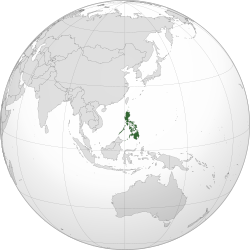
Maria Corazon "Cory" Sumulong Cojuangco-Aquino was a Filipino politician who served as the eleventh president of the Philippines from 1986 to 1992. She was the most prominent figure of the 1986 People Power Revolution, which ended the two-decade rule of President Ferdinand Marcos and led to the establishment of the current democratic Fifth Philippine Republic.
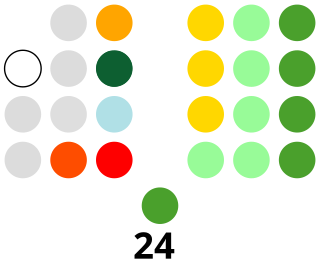
The Congress of the Philippines is the legislature of the national government of the Philippines. It is bicameral, composed of a lower body, the House of Representatives, although colloquially the term "Congress" commonly refers to just the latter, and an upper body, the Senate. The House of Representatives meets in the Batasang Pambansa in Quezon City while the Senate meets in the GSIS Building in Pasay.

The People Power Revolution, also known as the EDSA Revolution or the February Revolution, was a series of popular demonstrations in the Philippines, mostly in Metro Manila, from February 22 to 25, 1986. There was a sustained campaign of civil resistance against regime violence and electoral fraud. The nonviolent revolution led to the departure of Ferdinand Marcos, the end of his 20-year dictatorship and the restoration of democracy in the Philippines.
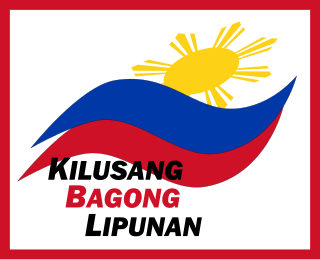
The New Society Movement, formerly named the New Society Movement of United Nationalists, Liberals, et cetera, is a right-wing political party in the Philippines. It was first formed in 1978 as an umbrella coalition of parties supporting then-President Ferdinand E. Marcos for the Interim Batasang Pambansa and was his political vehicle during his 20-year regime. It was reorganized as a political party in 1986, and is the furthest to the right of the political spectrum among active parties after Marcos' ouster.
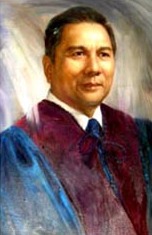
Marcelo "Celing" Briones Fernan was a Filipino lawyer and political figure. He is the only Filipino to have served as both Chief Justice of the Supreme Court and as Senate President. He is also the third Filipino to have headed both the judicial and legislative branches of government, after Querube Makalintal who served as Chief Justice and Speaker of the Batasang Pambansa in the 1970s, and José Yulo, who served as Chief Justice and Speaker of the House of Representatives before 1946.
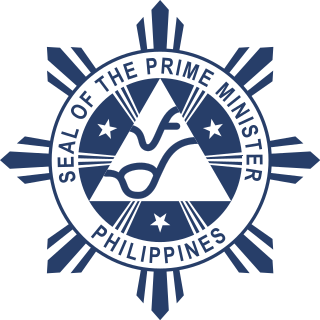
The prime minister of the Philippines was the official designation of the head of the government of the Philippines from 1978 until the People Power Revolution in 1986. During martial law and the fourth republic, the prime minister served as the head the Armed Forces of the Philippines. A limited version of this office, officially known as the President of the Council of Government, existed temporarily in 1899 during the First Philippine Republic.

The State of the Nation Address is an annual address by the president of the Philippines to a joint session of the Congress of the Philippines. Mandated by the 1987 Constitution, the speech is delivered every fourth Monday of July at the Plenary Session Hall of the Batasang Pambansa Complex in Batasan Hills, Quezon City.
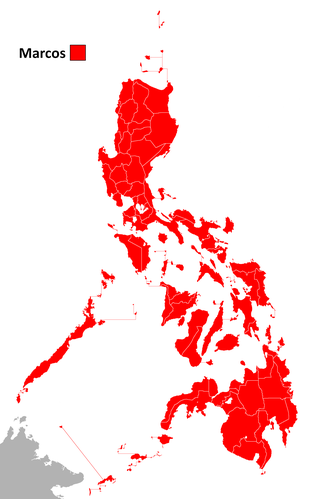
The 1981 Philippine presidential election and national referendum was held on June 16, 1981. President Ferdinand E. Marcos of the Kilusang Bagong Lipunan (KBL) defeated retired general and World War II veteran Alejo Santos of the Nacionalista Party in a landslide victory. Most opposition parties boycotted the election as a sign of protest over the 1978 election for the Interim Batasang Pambansa, which they condemned as fraudulent. At the same time, a national referendum was held on the question in holding elections for barangay elections in 1982.
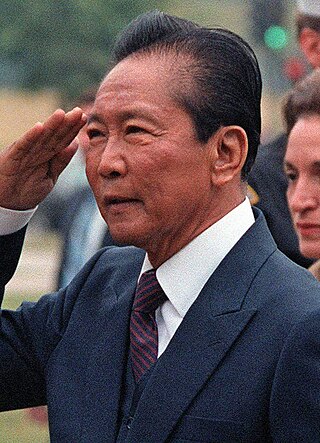
A parliamentary election was held in the Philippines on April 7, 1978, for the election of the 165 regional representatives to the Interim Batasang Pambansa. The elections were participated in by the leading opposition party, the Lakas ng Bayan (LABAN), which had twenty-one candidates for the Metro Manila area while the leading candidate was the jailed opposition leader Ninoy Aquino, and the Marcos regime's party known as the Kilusang Bagong Lipunan (KBL), which was led by the then-First Lady Imelda Marcos. Ninoy was allowed to run by his fellow partymates under the Liberal Party, who boycotted the election and was not allowed to campaign, and so his family campaigned for him. The night before the election on April 6, 1978, a noise barrage was organized by the supporters of (LABAN) which occurred up to dawn.
The Legislative district of Las Piñas–Parañaque was the combined representation of the Metropolitan Manila municipalities of Las Piñas and Parañaque in the Regular Batasang Pambansa from 1984 to 1986.
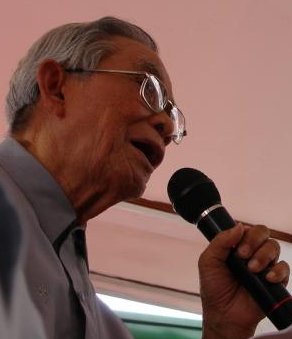
The 1987 election of members to the Senate of the Philippines was the 23rd election to the Senate of the Philippines. It was held on Monday, May 11, 1987. The Philippine Senate was re-instituted following the approval of a new constitution in 1987 restoring the bicameral Congress of the Philippines; earlier, a constitution was approved in 1973 that created a unicameral Batasang Pambansa (parliament) that replaced the bicameral Congress. The last Senate election prior to this was the 1971 election.

Cecilia Arreglado Muñoz-Palma was a Filipino jurist and the first woman appointed to the Supreme Court of the Philippines. She was appointed to the Supreme Court by President Ferdinand Marcos on October 29, 1973, and served until she reached the then-mandatory retirement age of 65.

A constitutional plebiscite was held in the Philippines on 2 February 1987. The plebiscite is pursuant to Presidential Proclamation No. 3 which was issued on 25 March 1986 by President Corazon Aquino. It abolished the Office of the Prime Minister and the Regular Batasang Pambansa. Multi-party elections were held accordingly in 1987.
The Regular Batasang Pambansa, or the First Batasang Pambansa, was the meeting of the Batasang Pambansa from the beginning of its session on July 23, 1984 until it was abolished by President Corazon Aquino on March 25, 1986.

The Fourth Philippine Republic, also known as the FourthRepublic of the Philippines was established after Ferdinand Marcos Sr won the June 16, 1981, Philippine Presidential Election. Marcos announced the beginning of the Fourth Republic on June 30, during his inauguration speech. On February 25, 1986, due to the 1986 EDSA Revolution, Marcos ended into exile in Hawaii and Corazon Aquino became the 11th president of the Philippines. The Fourth Republic would come to an end under Aquino's leadership, and the Fifth Republic would commence with the adoption of a new constitution.
The Constitution of the Philippines is the constitution or the supreme law of the Republic of the Philippines. Its final draft was completed by the Constitutional Commission on October 12, 1986, and ratified by a nationwide plebiscite on February 2, 1987.
1986 in the Philippines details events of note that happened in the Philippines in the year 1986.
Vicente Tirona Paterno was a Filipino businessman and politician. He served as Minister of Industry from 1974 to 1979 and of Minister of Public Highways from 1979 to 1980, during the Ferdinand Marcos' government. He also served as a member of the Interim Batasang Pambansa from 1978 to 1984 and later as Senator from 1987 to 1992.
The Philippine presidential line of succession defines who becomes or acts as president upon the incapacity, death, resignation, or removal from office of a sitting president or a president-elect.
